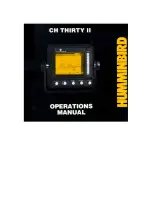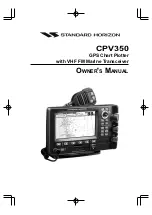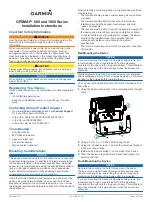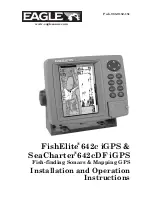
6. When an area is found that produces satisfactory operation, mark the location of the
transducer.
7. Remove the water and transducer and clean the marked area and the bottom of the transducer
thoroughly with lacquer thinner. Sand the area thoroughly.
8. Mix an ample amount of fiberglass resin without causing it to bubble and pour it in the area the
transducer is to be mounted. The puddle should be larger than the bottom of the transducer.
9. Coat the bottom of the transducer with resin, then put it in the center of the puddle and push
down on the transducer while moving it around in a circular motion. This forces out any air
bubbles that may be trapped between the bottom of the transducer and the hull of the boat.
10. When the resin has cured the transducer is ready to operate. No water is now required in the
bottom of the boat and gas and oil that is spilled inside of the boat will not degrade performance
as it will if the transducer is placed only in water.
Caution: Do not use silicone seal or any soft adhesive to bond the transducer to the hull. This will
reduce the sensitivity of the unit.
You may choose to install the transducer yourself inside the hull of your FIBERGLASS boat. If so,
we recommend a good, two-part epoxy such as the one available in our Humminbird epoxy kit.
We recommend the following steps:
Any style of Humminbird transducer may be installed inside the hull.
After selecting a clean, flat area, lightly sand until a smooth finish is obtained.
The divider of the two-part Humminbird epoxy kit is then removed and the two parts mixed
together thoroughly for about five minutes. By clipping one corner of the plastic envelope, a liberal
amount of epoxy is put on the face of the transducer and spread evenly with the applicator
provided.
Any remaining epoxy is then applied to the inside hull where the transducer is to be installed and
by using a circular motion to squeeze out all air bubbles, the transducer is placed into position.
Finally, by pressing down firmly and holding for a few minutes the installation process is
completed cleanly and efficiently. Now properly affixed, the unit should function accurately at all
speeds.
There will be cases where it is necessary to use a through-the-hull transducer. We offer a sturdy,
durable bronze housing which is ideal. for large boats or special applications. This transducer
comes standard with 20 foot cable. It will be necessary to bore a 13116 inch hole through the hull.
If the hull has a curvature, it will be necessary to use a fairing block, shaped to fit the inside and
outside contour of the hull. These can be made of hardwood, casting resin or any other suitable
material. The fairing blocks should be cut or molded to the same dimensions as the head of the
transducer and thick enough to compensate for the contour of the hull. See Figure 5.
Caution: The hull of a wooden boat will tend to shrink when left out of the water for a prolonged
period of time. The nut should be hand tightened only, until the hull has had a chance to swell.
This should take about a week. The nut can then be tightened securely.
Summary of Contents for CH Thirty II
Page 1: ......



















